Your cart is currently empty!
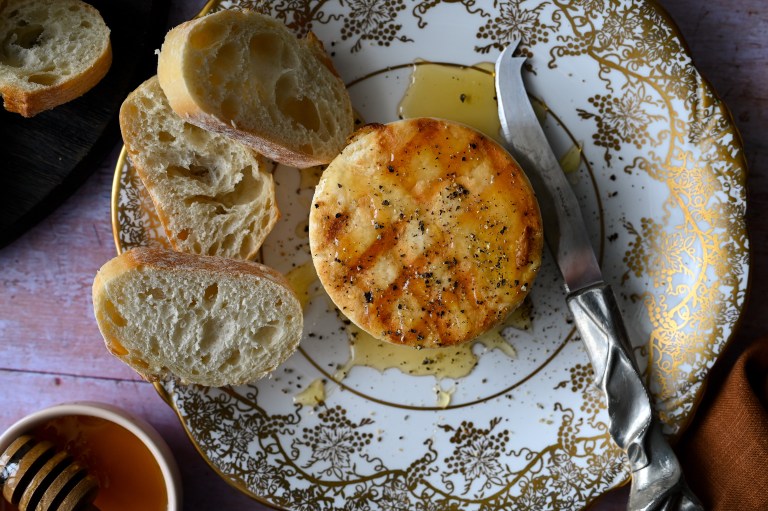
Taking the guesswork out of Greek cooking…one cup at a time
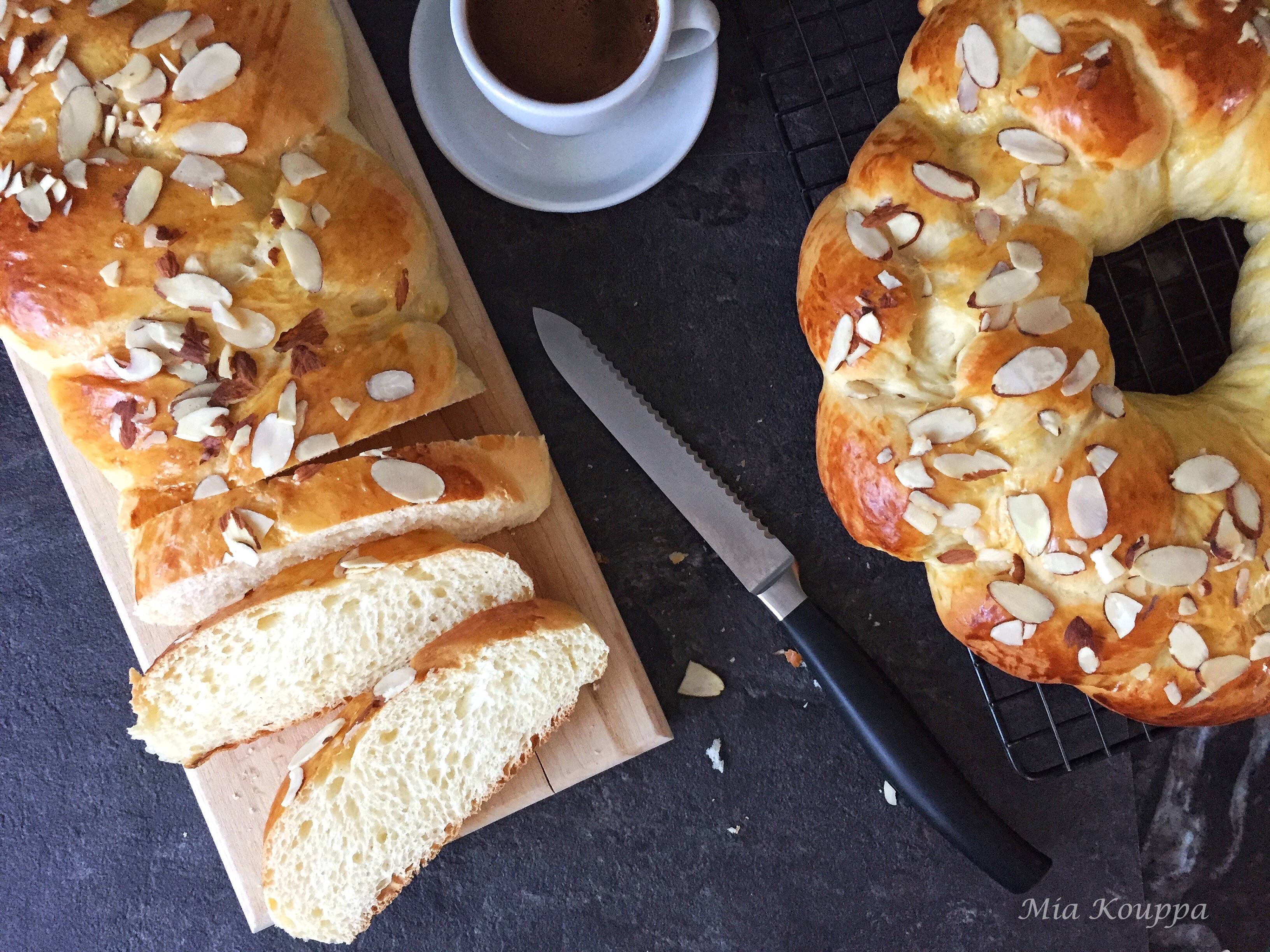
The fluffiest and most delicious traditional tsoureki, or Greek Easter bread, flavoured with masticha and mahlepi.
Sweet is the day that you decide to devote some time to making tsoureki, the traditional Greek Easter bread which is often served to break the Lenten fast. On Easter Sunday it is offered to family and friends as a way to express friendship and love. Godparents often include a loaf of tsoureki in the Easter presents they give their godchildren, tucked into the gift basket next to the shoes, and the lambada (Easter candle).
Similar to Jewish challah bread, tsoureki is sweet, soft and fluffy. What sets it apart from other egg- enriched breads however are the flavourings of mastiha and mahlepi. Although these unique ingredients are key, and present in almost all tsoureki recipes, there are countless variations, with some families adding additional flavours of orange or brandy or other nice things.




For many years our parents made tsourekia the way they make everything…intuitively. And, as usual, they were very successful, each year offering us delicious loaves of sweet bread. We would receive one large tsoureki loaf per family along with mini-loaves for each grand-daughter. We happily accepted their offerings, never attempting to make tsourekia on our own; it just seemed too complicated. Then, as years went on, we each decided that with all of the actual recipes available online, it was time to try baking tsourekia ourselves. We wanted our homes to smell delicious. We wanted to bake something so important to our culture and family traditions, something we could be proud of. But which recipe to trust? Not knowing which recipe to try, we tried many and we had varying degrees of success…and some epic fails. Our biggest disaster was the year one of us (it doesn’t matter who…okay…it was Helen), attempted a recipe and ended up with what we affectionately labeled Tsourocki. Literally…it was as heavy as a rock. A big rock. Almost a boulder. It was ridiculous.
And then one day, perhaps after hearing about the “Saga of the Tsourocki”, we were handed a tsoureki recipe from our cousin Effie (thanks Effie!) who herself got it from a friend (thanks Effie’s friend!). This tsoureki recipe has now been adopted by all of us, even our parents! If you give it a try you will see that it is quite simple, almost failproof, and absolutely delicious. We’re pretty sure that if you try it, you might want to adopt it too.

Helpful hints
Like most yeast breads, tsourekia require two risings. Although the active time you need to invest is significant, you also have to factor in the waiting around time you need for the yeast to do its thing. Making tsourekia is really an activity that you need to schedule and plan out, so that you can enjoy the process without feeling overwhelmed.
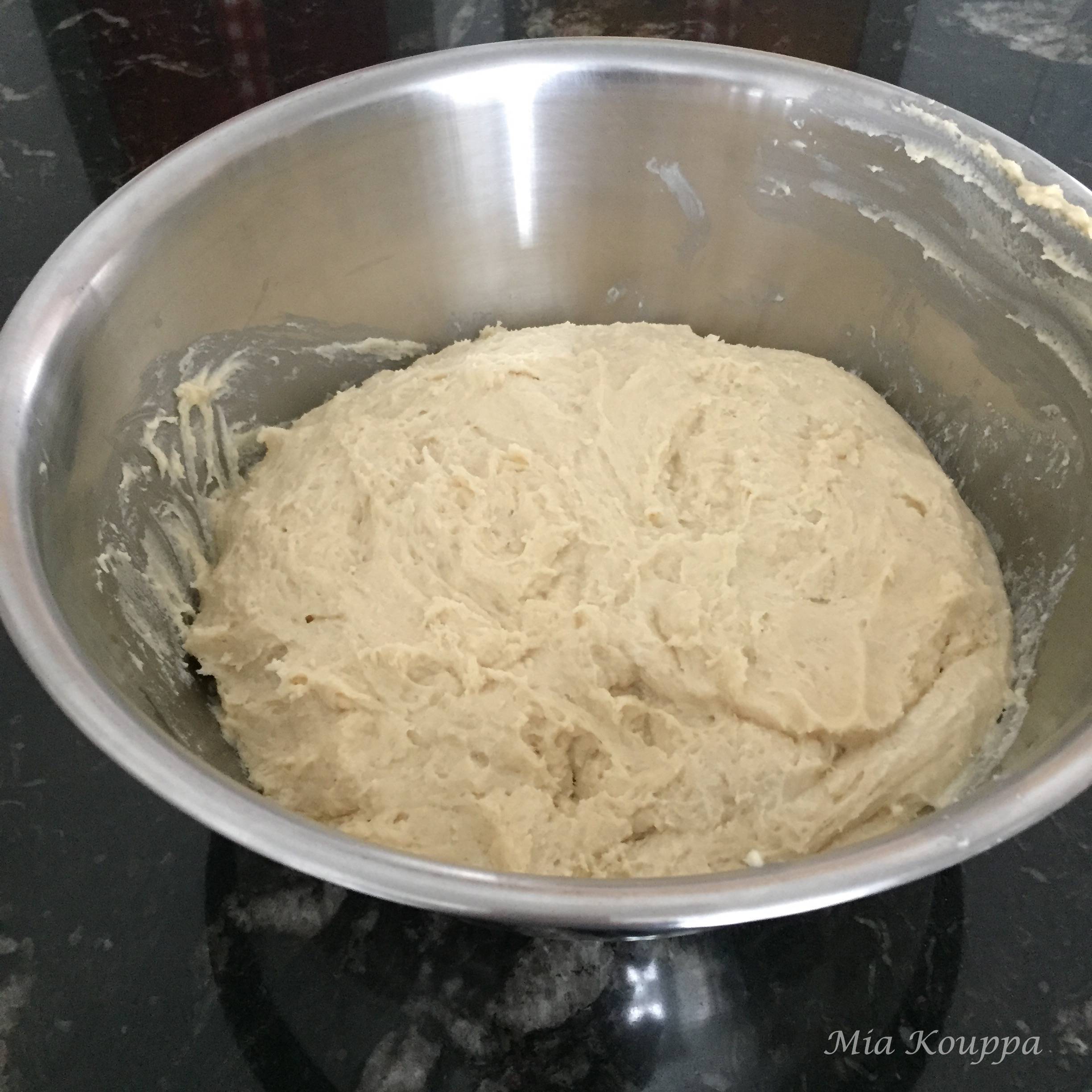
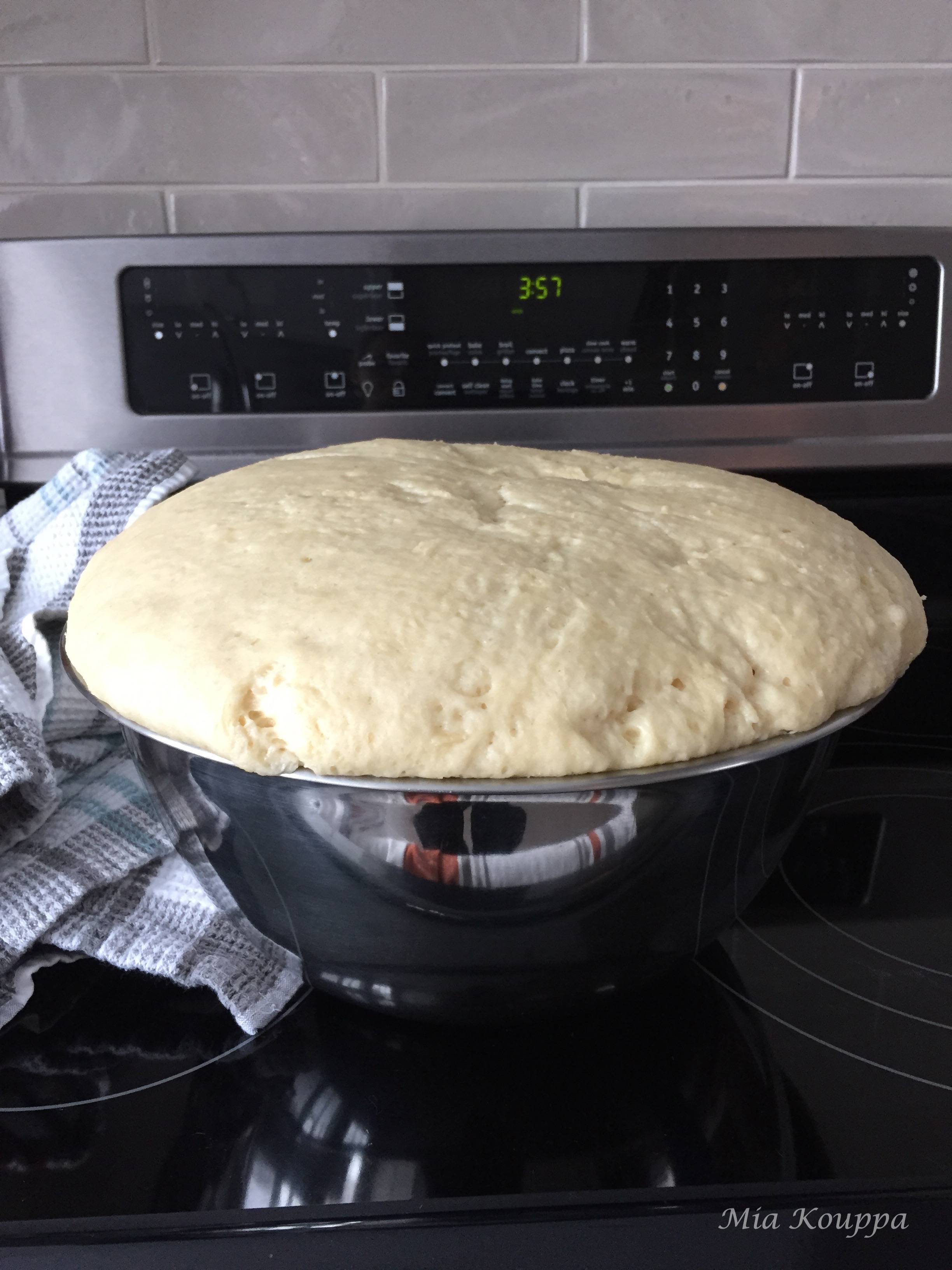
Traditionally, Easter eggs are dyed on Holy Thursday. If you will be making your tsourekia after you have dyed your eggs, you can insert one of the red eggs into the top of the braid immediately after shaping the loaf. The dough will then rise around the egg holding it in place, even after baking. The red egg is meant to signify the blood of Christ, as well as rebirth and renewal.
This recipe calls for a total of 24 grams of dry yeast. We have made the tsourekia with both active dry yeast or the fast rising yeast; both varieties seem to work just as well. We use packets of yeast that come in 8 gram packs, so we use 3 of the packs for this complete recipe. If you don’t have yeast available this way, you will have to weigh it out. Regardless of the brand of yeast you use, be sure to check the expiry date. Unlike many products which may be okay to use past the date on their container, yeast is not one of them. It is so disappointing to set to baking something only to realize that your yeast is no longer active.
In order to activate the yeast you must mix it into lukewarm water, somewhere between 100 – 110 degrees Fahrenheit. If you don’t have a way to measure the temperature, just be sure that the water is warm (not hot!) to the touch. We usually place tap water in a bowl and leave it on the counter for an hour or so and that seems to work.
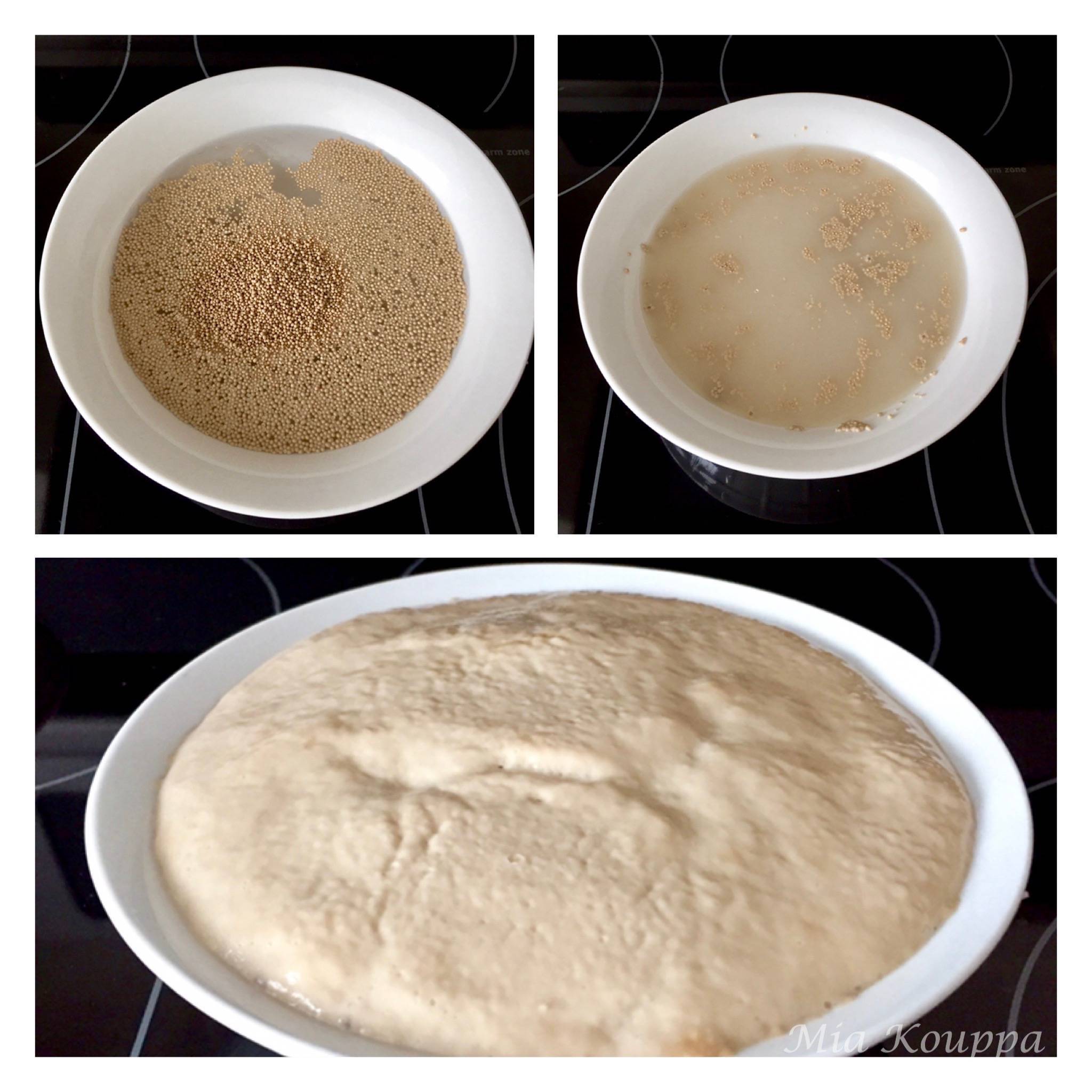
The recipe also calls for lukewarm milk. We use the same approach in that we measure out the milk and leave it on the counter for a couple of hours. We usually use homogenized milk for the tsourekia, but 2% milk would work as well (we’ve never tried it with skim milk).
Two of the key ingredients in tsourekia are mahlepi and mastiha. Both of these are critical to making tsoureki; without them you basically have sweet bread. Delicious still, but not tsoureki.
Mahlepi (also called mahleb…although we’ve never heard it called mahleb) is the aromatic spice found in the seeds of the St. Lucie cherry. The cherry stone is broken open to reveal a small seed inside. This seed is then ground up and used in baked goods, like tsoureki. We would really like to know who discovered this little seed, and we hope that his or her name was Mahlepi…they deserve to be recognized for this bizarre and wonderful discovery. If you can, purchase the mahlepi seeds whole and grind them up yourself in a spice grinder or using a mortar and pestle. This will ensure a fresher taste.
Mastiha (or mastic), the other key ingredient in tsoureki, is also available in whole pieces which you can then grind up using the same spice grinder or mortar and pestle. The pieces themselves are slightly translucent, resembling bits of broken glass but when crushed, the powder is a snowy white. Pretty cool. Mastiha is the resin of the Mastic tree which is found only on the island of Chios in Greece; it has a Protected Designation of Origin in the European Union. It forms the base to chewing gum and in fact, if you pop one of the mastiha pieces into your mouth and chew, you make gum!

Both mahlepi and mastiha can be a little difficult to find, and even in Greek markets, they are often only available during the holidays. If you cannot find these two key ingredients in shops near you, you can certainly order them online. We’ve added links in our Recipe. Please note that the amounts indicated in the recipe below are for the crushed, or ground, mastiha and mahlepi.
One of the trickiest parts of this recipe is shaping the tsourekia because the dough is quite sticky. Rolling it on a lightly floured surface works, but we have discovered that air rolling (have we just invented A Thing?) is so much more effective. We have also found that letting the dough sit for about 20 minutes, after separating the dough, into your 6 pieces, makes it more manageable. We have included a video so that you can actually see what we mean as describing it in written steps (although we tried) may be confusing. Watch the video and give it a try. Once you get the hang of it you will see that it is really worth any failed practice attempts. Besides, this technique provides much comedy for those dirty-minded individuals who may be watching you.
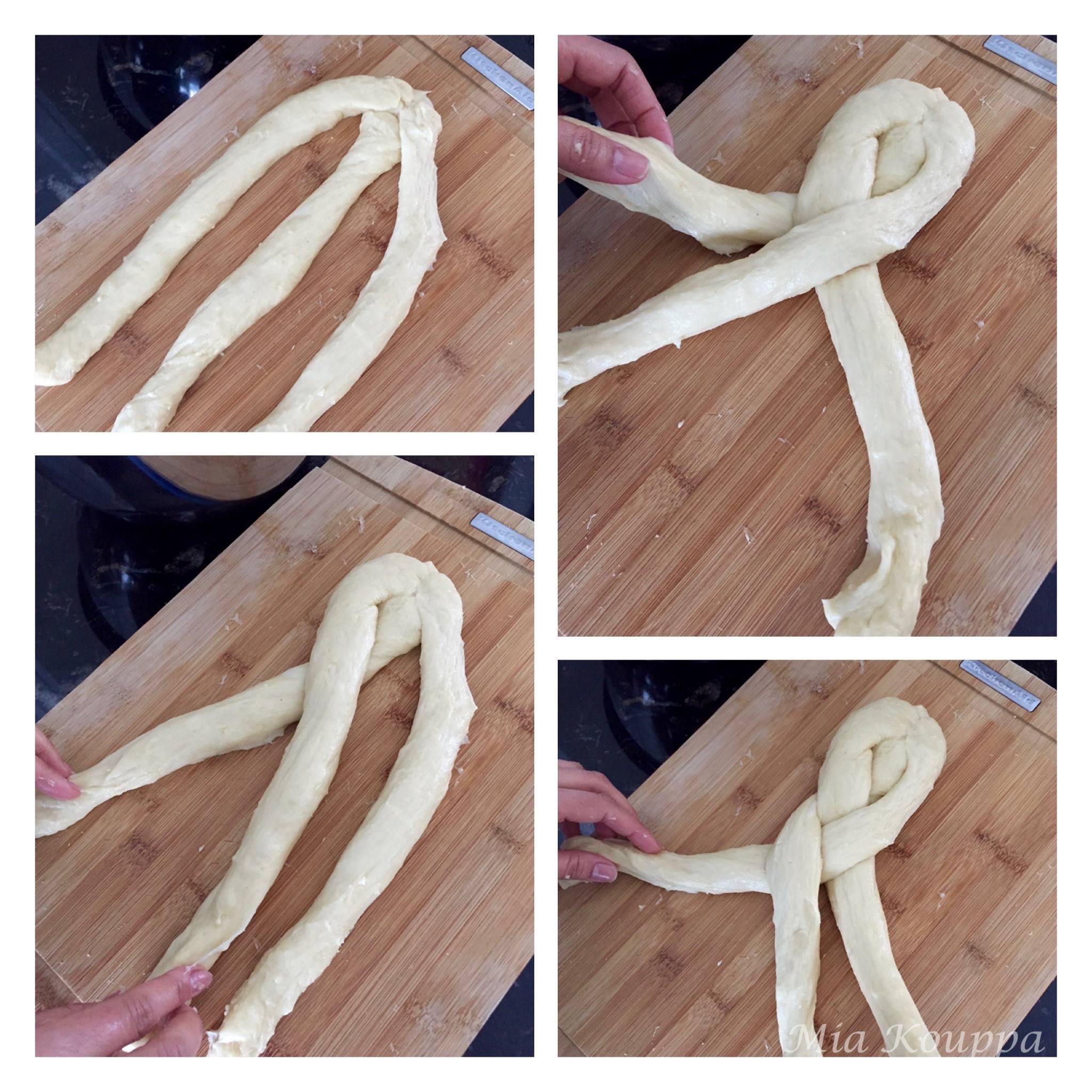
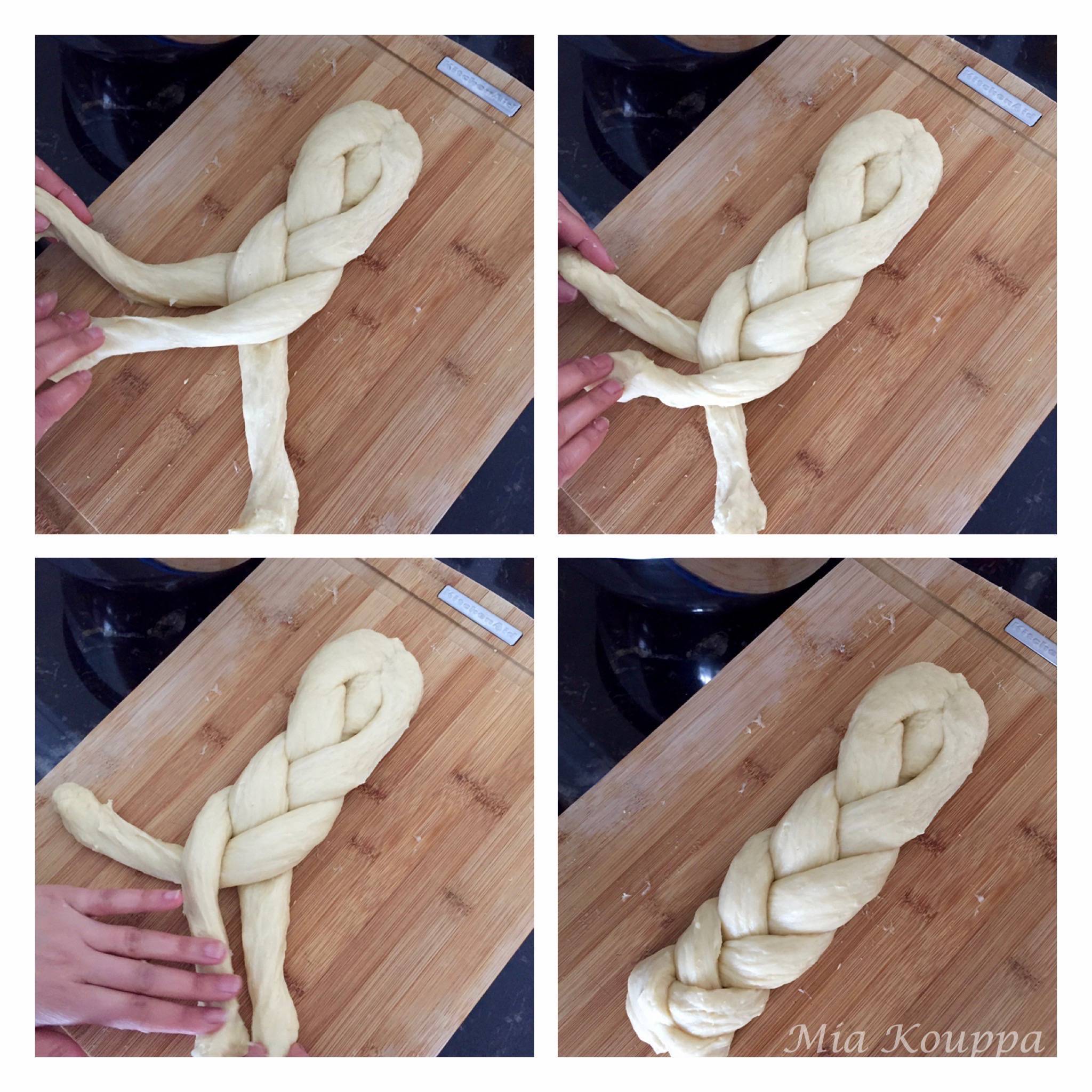

Check these tsoureki inspired recipes:
Tsoureki and feta grilled cheese
We love hearing from you! If you have made our recipes, or if you have a question or comment, or simply want to say Hi!, please leave a comment and star rating below! Also be sure to follow along with us, on Facebook, Instagram and Pinterest. We have lots of fun over there.
This post may contain some affiliate links, which means that we make a small commission off items you purchase at no additional cost to you.
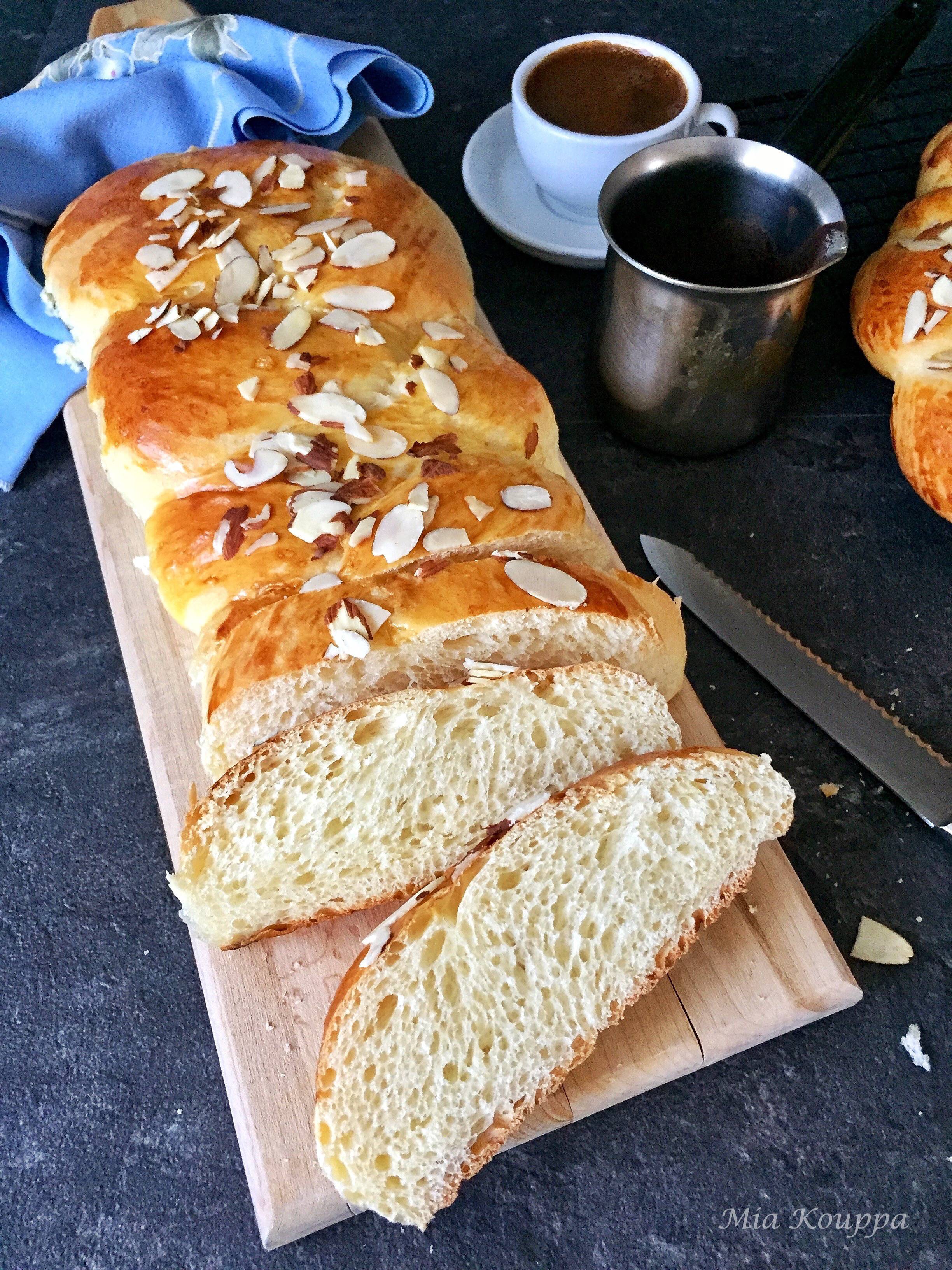
This looks great! Can’t wait to try. Is there a place in the WI where I can get mahlepi and mastiha?
Hi Angela, I am not sure. If you have a Mediterranean grocery store near you, they would carry it; however, I believe you can find both of these items on Amazon. Let us know if you can make them, and how you like them 🙂
Aphrodite bakery on des Sources
I look forward to trying this out! My husband’s family is from Messenia (Nea Koroni) and I always remember how good the food was when we visited. Thanks for the wonderful recipes.
Thank you Lena 🙂 Our parents are from Messinia as well so you will definitely find more familiar recipes here. Let us know, if you try the tsoureki, how it turns out 🙂
Definitely going to try this. I want surprise my mom
OH that is so sweet! Let us know if you have any questions at all while you are making it
Looks and sounds very tasty, a lovely recipe indeed !
Thank you 🙂
One more question! Do you measure the Mastiha before or after it’s crushed? The picture has it before so I’m trying to figure out if I bought enough…. TIA!
Oh….good question. The measurement is for the mastiha when it is crushed. We will make a note in the recipe as others may also have that question. If you run a bit short…don’t worry too much (we are ALL about not worrying too much 🙂 ). Just use what you have. It is a flavouring, and so won’t affect the actual texture of your tsoureki.
[…] a community affair, starts days earlier. Whether it is getting together to bake koulourakia and tsourekia, dyeing eggs with the children, or setting up the souvla, there is much work to be done, and many […]
[…] you ever have too much of a good thing? We don’t think so. Tsoureki is one of those very good things, and like us, you may find yourself having an abundance of it at […]
[…] are many ways to bake a vasilopita. Some versions are very bread-like, and similar to the Easter tsoureki. Other versions, like our parents’ recipe which follows, are more cake-like. Both are […]
I’ll be trying this recipe this year! Do you think leaving the tsoureki to rise overnight is a good idea (first rise)? The recipe says to let it rise for 3 to 4 hours, but from past experiences, mine always seem to take much longer. Hoping to save some time with it rising overnight 🙂 thank you !
Hi Georgia. If you follow the recipe as is, then 3 – 4 hours will definitely be enough time. However, if you want to try to allow it to rise overnight this is probably going to be fine (can’t promise it however…as we’ve never tried!). Do let us know how it works out if you do – our gut tells us it will be fine! 🙂
[…] One of the things that our Easter season seems to leave us with plenty of is tsoureki, and we’re thrilled. It seems that most Greek homes bake a huge number of these sweet […]
[…] Tsoureki is a traditional Greek Easter bread which is sweet and uniquely flavoured with mahlepi and masticha. Almost like a Jewish challah bread, it is typically braided and the crumb is a lovely, scented yellow colour. It is such a delicious bread, which is so plentiful during Easter time, that it only seemed logical to use it in order to take a North American classic and give it a Greek twist. […]
I used this recipe for a Vasilopita bread (my family likes the Vasilopita that is more like bread than cake). My husband said it was the BEST he ever had! And it was even easier because I did not have to make the braid. I just put the dough from half of the recipe in a round 12 inch pan – great fit.
Had comical difficulties trying to make this for my friends. Getting the mahlepi and mastica was an Odyssean endeavor in itself (finally ending in success at the local arab store). My mother-in-law pulled out a huge cookbook (Tselementes) and started to translate recipes in kilos. When I asked another person how much of different things to add and what kind of pan to use, they repeatedly answered, “osopare.” And exactly how to knead the dough? “Oh, you just do it in a way that makes it nice…”
So I am very happy to have a great and demystified recipe. My family will pass it down and treasure it.
Sending all of your family a huge ‘epharisto’ for sharing.
[…] you ever have too much of a good thing? We don’t think so. Tsoureki is one of those very good things, and like us, you may find yourself having an abundance of it at […]
i decided to try your recipe for tsoureki a bit early this year , and I will say they are delicious !!! My issue was they really did not rise as much as i would have liked . I used the 3 packets of yeast (although that was not quite the 24gr mentioned in your recipe, it was only 21gr) The yeast was fresh , I let it rise like your images, allowed the dough to rise for 4+ hours and the dough was sticky per your instructions ,using 8 cups of flour per the recipe. My tsourekia came out somewhat flat , and the braids were not distinguishable once they baked. So my question is , if I add more flour to make a somewhat stiffer dough will this make the breads rise a little more and seem more like the tsoureki in the picture, or will this cause a tsourocki situation…..I imagine i will need to use some additional yeast as well
BTW , i made paximathia out of the flat tsoureki and they are wonderful!
Hi Maraki!! Thanks for your message, and we’re so glad you found the tsoureki delicious. We would say that the next time you make this recipe, add the 24 grams of yeast and see what happens. Adding additional flour makes us a bit nervous as it would change the texture of the dough; part of what makes these tsourekia lovely is that they are light. Smart though to use the flat tsoureki to make paximathia!!!
THANK YOU! Made this Last night they were super fluffy tasted it this morning fantastic…recipe a keeper.. wish I could post pic… any recommendations on baking pan mine tends to blacken the bottoms even with parchment? Καλό Πάσχα
Oh amazing Lori!! Thanks for making Mia Kouppa part of your Easter 🙂 We’re so glad that you loved the recipe. If your tsourekia are blackening on the bottom, be sure that you are using the middle rack of your oven; anything too low may be causing the bottoms to get to dark. If you already are, or if that doesn’t work, try a lower oven temperature. You may need to bake the tsourekia for longer, but hopefully you won’t end up with dark bottoms. Kalo Pascha!
Have you ever tried this using Tsoureki flour specifically? I was able to purchase some from the local Greek Store but I have no idea if I have to alter the recipe at all because of it!
Hi ,this will be my first attempt at making tsoureki and was just wondering if I can using farina flour (recommended by my mother in law) instead of all purpose flour? or are they the same ??
Hi Alexia! Thanks for your question and for stopping by Mia Kouppa! Although we would hate to disagree with your mother in law…baking is quite tricky sometimes. Given that we have only ever made our tsourekia with all-purpose flour we would be reluctant to suggest something else. What we can say is that with the regular all-purpose flour, the tsourekia turn out great! We hope your mother in law will approve 🙂 🙂 Kali Anastasi!
Hi there! Have you ever tried to make this with tsoureki flour? I found some at the Greek store and not sure if anything needs to be changed in the recipe if I use it. Thanks!
Hi Mary! Thanks for visiting Mia Kouppa. Actually, we have never heard or seen tsoureki flour. We don’t think this is something we have readily available where we live. However, we always use regular, all-purpose flour for our tsourekia, with great success! Hope this helps! Happy baking and Kali Anastasi 🙂
Greetings from Sydney Australia, you have great recipes, your version of Melomakrona is better than my MIL – that says a lot 🙂 Will make the Tsoureki tomorrow morning – looking forward to it.
Kali Anastasi
Hi Adriana! Thank you so much for your comment and we are so happy that you are enjoying our recipes. Your comment about your MIL made us chuckle 🙂 We hope you have a wonderful time baking your tsourekia using our recipe! Let us know how it goes and Kali Anastasi! 🙂
Christos Anesti! I just made this recipe and it is divine! Tastes like grandma used to make and I am passing the tradition down to my kids who went wild for it. Thanks for sharing- I enjoy all your recipes- they remind me so much of my grandma.
Oh thank you so much Carine, and thank you for taking the time to drop us a note. We are thrilled to hear that our tsoureki allows you to pass on a tradition to your kids, and that our recipes remind you of your grandma. This has made our hearts soar!!
Hello I love this recipe I have made them a few times now. My question is that 24 grams according to the packet weight is only one packet. I believe I have used about two and it took longer than 4 hrs more like 5-5.5 hrs. I checked the yeast and it was active and the water was like warm so I am not sure why it took so long. Any ideas? So if you had to translate to the amount of packets of yeast how many? Thank you!
Hi Angela! Thanks for stopping by, and for your question. We’re so glad that you love our tsoureki recipe! It is certainly one of our favourites. Packets of yeast vary in weight, depending upon the brand, and where you live. For us, 24 grams would be a bit more than 3 individual packets of the yeast which we purchase. The best thing is to check the weight written on each little packet, or to purchase a kitchen scale; some of them take very little space and are inexpensive. We hope that this helps! Please let us know if you have further questions.
I made this recipe the other day but have found that it’s very crumbly…. why?
Hi Kathy, oh we’re sorry to hear that. It is a very fluffy Tsoureki, very light.. but we’ve never had it crumble. The only thing we can think of, is perhaps it was baked too long? We hope you enjoyed the taste though.
Is it possible to make half the recipe? Can you also tell me how many teaspoons of yeast the recipe requires instead of grams?
Sorry for the late reply. It’s probably too late, and we apologize for that; however, yes, you can halve the recipe.. 24 grams is 6 teaspoons of yeast. We hope you had wonderful Easter.
HI! Being that this was going to be my first time making tsoureki, I researched many recipes and yours looked the most comprehensive so I gave it a go. I’m happy to say that it turned out great thanks to your excellent directions, so THANK YOU!! They are delicious and fluffy and the loaf designated for my family was gone in a minute, so thank you SO much. I did however, need to add more flour about 1-2 cups more, I’m not sure because I was adding “me to mati”. Also, in my oven, they cooked in 15 minutes, so keep an eye on your tsourekia!! I passed this recipe on to my cousin and sister-in-law and they also loved it so thank you for now being a part of our Easter family tradition!!!
That”s so great to hear Tonia 🙂 We are honored to be part of your family’s Easter tradition 🙂 Xristos Anesti! Definitely cooking times are not an exact science which is why we always try to describe what your finished product should look like; ovens are all different. Glad you made adjustments so that your tsourekia turned out just right!
I’m dying to try this! Will it work with any flour? I read in other recipes that it has to have at least 10% protein, and I can’t get it at the moment…That’s why id didn’t make any this easter, but better late than never, right?
We hope you do try it, and love it 🙂 We’re in Canada and we use All-purpose flour which has 13% protein, so not sure how it would work out with flour that has no protein. Maybe you can try it as a half recipe? (and let us know!) Happy baking 🙂
Χριστός Ανέστη!
Not being able to find mahlepi or mastiha, I called friends in the same boat and decided to go with 1 T vanilla, 1 C oj, zest of 1 orange and cinnamon.
My biggest issue was braiding the dough… it was so wet and sticky and I lost track as to how much flour I added along with oiling my hands with vegetable oil.
Amazingly enough… the tsoureki was fabulous! Best tasting I ever made! Didn’t look as good as it tasted though!
Do you have any suggestions for my next try… in a couple of weeks? My husband loved it too!
Many thanks and we love your recipes… thanks for all you both do! Stay safe!
Hi Christine. We are so happy that you tried our tsoureki recipe and loved it. Great idea for the substitution in flavours given you couldn’t get masticha and mahlepi. The dough IS very sticky! Did you watch our videos incorporated into the post? We have found that making the long pieces in the air is the easiest way. As for the braiding, it takes practice. It’s important not to try to get away from the stickiness too much because too much flour won’t result in a nice soft crumb. After you roll out your long pieces you can lightly dust your work surface with flour and shape them on that. You can also shape them on a lightly floured piece of parchment paper that you can then transfer directly to the baking pan. Good luck and happy baking! 🙂
So many thanks for your response! I created all 6 Tsourekia by air rolling… it was great! That’s after lots of extra flour and oiling my hands like crazy. I’ll try again! Keep up the great work… love your recipes and the way you present them… thanks much!
You’re so welcome! Thank you so much. We’re so glad you’re here with us, and enjoying our recipes 🙂
Thank you for the laugh! I went through the exact same process (experimenting) for the exact same reason (the family’s official bread maker passed away – memory eternal, but she took her recipe with her). I made so many bricks! I made some with so much flour (to get rid of the stickiness) that they were fit to burn as logs in the fireplace. I made some that looked amazing – only to cut them and discover that the middle was a mass of dough. I made some that were, essentially, bread-shaped balloons – enormous bubbles with a skin of bread crust. My family would roll their eyes and cringe every time I said i was going to try to nail down yiayia’s recipe. Because the house would always smell amazing, but the loaves were always impossible to eat.
After years of trial-and-error, I finally pieced together the right combination. I could have saved myself a whole lot of failure had i just visited this website first, because the recipe i came up with is nearly identical to yours! The only suggestion that I can make is to use bread flour instead of all-purpose flour. It seems like the texture gets much fluffier that way.
I did pick up a few pointers, which I am eager to try next time. Thanks for the chuckle, and the confirmation that I’m on the right path!
Hi Mike! Thank you so much for your message, and we really appreciate you taking the time to read our post, and comment 🙂 (and we’re glad we could give you a chuckle!). So great that you have finally gotten the tsoureki recipe right; we know ALL about trial and error. You idea for bread flour is a good one; we might just try that next time. Have a great rest of the week, and we hope that you continue to find recipes and posts to enjoy here. xoxo Helen & Billie
Thank you for this recipe! My family loves it!
I’ve tried other recipes trying to recreate our family’s recipe and they weren’t as fool-proof as this one! (For a laugh, the way I found the recipe because I forgot to bookmark your page was by googling “tsouROCKI!” haha
I usually halve the recipe and then regret not making the full amount, I could eat a loaf on my own. Thanks again for sharing!
Vikki, your comment had us laughing out loud!! The fact that you found it again by googling “tsouROCKI” is THE BEST!!!! And we are so happy that you love this recipe as much as we do! And yes, next time make the full (or double!) the batch 🙂 xoxo Helen & Billie
Just made these yesterday and I have to say they are so flavourful and fluffy. They were everything you said. My home was filled with the delicious aroma all day! I will be adopting this recipe from now on. If anyone is hesitating in attempting it…don’t! Easy and so worth the time. Thank you for sharing the recipe.
Yay!! We are so happy to hear that Anastasia! Thanks so much for trusting and trying our recipe, and for the rave review!! We really appreciate you taking the time to comment. Kali Anastasi! xoxo Helen & Billie
Amazing recipe! My tsourekia turned out perfect! I stuffed two of them with Nutella also. Only tricky part is working the dough as it IS very sticky… nothing that a little olive oil can’t fix 😝 perhaps next year I will add a little orange zest for that little kick but otherwise the tsourekia turned out light and fluffy, not too sweet, everything you would expect from tsoureki! Thank you so much for the recipe!
How happy your comment has made us Nicole!! We love that you tried our recipe, and loved it. The addition of Nutella…yum! And yes, it is a very sticky dough – but you managed to make it work! So happy. Have a great day! xoxo Helen & Billie
Χριστός ἀνέστη! I made this recipe on Saturday and I am so happy with the results. It was the first time I attempted to make tsoureki on my own and this recipe is indeed foolproof! It was a hit at the Easter table yesterday and today I am trying real hard to stay out of the kitchen not to go for a 3rd piece! 🙂 Thank you to you ladies and to your cousin Effie. The recipe is a keeper!
Thank you Maria!! We are just thrilled that you tried our recipe, and loved it. Thank you for including Mia Kouppa on your Easter table – we are truly very grateful! xoxo Helen & Billie
Xristos Anesti! Your recipe is wonderful! I tried making tsourecki last year with a different recipe and ended up with a tsouROCKi even the birds would not touch. This year, using your recipe, it was perfect. Very easy to follow. Thank you!
Alithos Anesti. Thank you so much Mary! So happy that you found our recipe and that you love it! Hope you find more to love here 🙂 xoxo Helen & Billie
How do you manage baking 6 loaves of bread at once?
Hi Susan, We wish we could say that we have an industrial kitchen that handles all these loaves at once, but we don’t 🙂 We shape all of our loaves and then bake them in stages – usually 2 or 3 at a time, or whatever fits in our oven at one time. While the first batch is baking, the rest of the tsourekia just benefit from a little longer resting / rising time. Hope that helps. xoxo Helen & Billie
Just finished my first batch of 2022! Been using this recipe without fail for the last couple of years. So easy and tasty. My only adjustment is I add orange zest to my dough as mom used to do. Wishing you both Kalo Pascha.
We are SO happy to hear that you have come to rely on our recipe Lori! Thank you so much for taking the time to let us know! Kali Anastasi and thank you for being here with us! xoxo Helen & Billie
Thanks for the recipe! I prepared it today for Western Easter, and it was delicious!
I had to add something like 11 cups of bread flour to get to the consistency shown in the video, otherwise the dough was too liquid. I am at high altitude, maybe that’s why. And it turned to be on the darker side, and absolutely humongous. You can tell I am a beginner baker.
But I totally achieved the texture (I think), and everybody thoroughly enjoyed it!
Hi Bridger! Thanks so much for taking the time to comment, and for trying our recipe! Altitude definitely plays a role when baking so we’re happy that you figured out a way to adapt the recipe so that it worked out for you. So happy that everyone enjoyed it. And remember, we were all beginning bakers…in the beginning! Hope you find much more to love here with us. Happy Easter! xoxo Helen & Billie
Leave a Reply